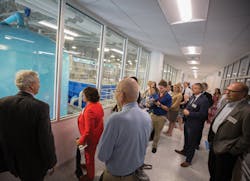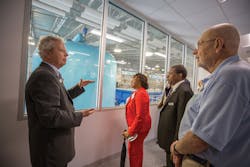Expanding efforts in potable reuse can augment water stores and safeguard drinking water supplies for years to come.
Global interest in water reuse — the use of treated wastewater for beneficial purposes, including drinking water augmentation— is on the rise, and for good reason. The practice could significantly increase total available water resources. In fact, a growing number of municipalities are already using highly treated wastewater to replenish groundwater stores, including those in water-stressed areas like California and Texas. In places like Colorado, Oklahoma and Florida, interest in potable reuse is growing as well.
According to EPA’s 2017 Potable Reuse Compendium, ”Appropriate and necessary treatment and reuse of wastewater to augment existing water resources is a rapidly expanding approach for both non-potable and potable applications. EPA recognizes that potable reuse of water can play a critical role in helping states, tribes, and communities meet their future drinking water needs with a diversified portfolio of water sources.”
SWIFT Research Center. Photo courtesy HRSD.
While early pioneers in water reuse have done much to advance the practice nationwide, there are still barriers to broader implementation across state lines.
A recent EPA report aimed at helping municipalities and utilities considering potable reuse to develop their approach defined different types of water reuse. Mainstreaming Potable Water Reuse in the United States: Strategies for Leveling the Playing Field states, “As with the development of any water source, utilities and planners must carefully evaluate the potential costs, benefits, and drawbacks of potable reuse within a broader water planning and watershed management context. This requires understanding community values and priorities and examining how different supply options may affect or be affected by existing governance structures, wastewater and stormwater management systems, sustainability goals, and local or regional long-term planning processes.”
Here, we outline some common approaches to gaining the support needed to develop a successful water reuse program.
Communicate a Common Message
Municipalities and utility companies with effective communication strategies already in place will need to ensure consistency in their messages about their water recycling program. For those agencies without an established preferred method of communication with ratepayers and the public, proactive and consistent communication will be key. Communication channels that include consumers, elected officials, regulators, advocacy organizations, media outlets, and utility staff throughout the stages of project development will have the best results.
Community members and public officials were given tours of the SWIFT Research Center Ribbon Cutting on May 18, 2018. Photo courtesy HRSD.
Example: Hampton Roads Sanitation District
The Hampton Roads Sanitation District (HRSD) serves 18 cities and counties in southeast Virginia, with a service population of 1.7 million. Its Sustainable Water Initiative For Tomorrow (SWIFT) project will take highly treated water that would otherwise be discharged into local rivers and put it through additional rounds of advanced water treatment to meet drinking water quality standards. The SWIFT water will then be added to the Potomac aquifer, where it will indirectly supply sustainable groundwater for future generations.
In May 2018, during an opening ceremony at the $25 million demonstration facility, HRSD General Manager Ted Henifin highlighted the broad stakeholder support for the program and attributed it to maintaining open communication and transparency throughout the process. “HRSD has been laser-focused on the science of advanced water treatment throughout the development of SWIFT,” he added, “and has taken advantage of various independent experts and panels to ensure SWIFT water is protective of public health and the Potomac aquifer today and for all future generations of Virginians.”
Prior to starting work on SWIFT, HRSD identified key stakeholders in the project and communicated with them throughout the planning process. The utility’s staff met with community members and made the case for SWIFT with political leaders, educating them on the treatment process. The utility has received widespread support throughout its service area, thanks in large part to its transparency in communications early on — and often.
Recently, HRSD was recognized by the U.S. Water Alliance with a prestigious U.S. Water Prize for the SWIFT project.
HRSD General Manager Ted Henifin addresses guests at the SWIFT Research Center. The project recently won a U.S. Water Prize. Photo courtesy HRSD.
Example: City of San Diego
San Diego County currently imports 85 percent of its water supply. The Pure Water Program seeks to provide a local, sustainable water supply for the future, independent of these imports. Through the design and construction of new advanced water purification, pumping, and delivery systems, as well as upgrades to existing facilities, the program will treat 83 million gallons of wastewater per day to produce one-third of the region’s water supply (by 2035).
Recently, the project’s Environmental Impact Report and Environmental Impact Statement (EIR/EIS) was certified with help from consulting firm Dudek. Dudek analyzed potential environmental impacts associated with construction and operation of the Pure Water San Diego facility, as well as long-term effects associated with changes in water supply.
“The Pure Water San Diego project sets a new nationwide precedent for water recycling on such a grand scale,” said Dudek Project Manager Shawn Shamlou. “It’s very difficult to build miles and miles of pipeline without eventually [having some sort of environmental impact]. The city was very forward-thinking in terms of planning, spending a lot of time and effort on pursuing the greenest, most resourceful project.”
The EIR/EIS is one of three that will need to be completed to encompass the entire project scope.
“This is just the tip of the iceberg, the first of many efforts not only in San Diego, but in Southern California and elsewhere,” Shamlou said.
The State’s Role
Without federal regulations on potable reuse, state drinking water agencies are the primary bodies establishing regulatory and permitting approaches tailored to the rules, needs, and stakeholder interests in their respective states. The state-by-state approach, according to EPA, “appears to provide many advantages and has encouraged innovation that has resulted in the development of safe and reliable projects.”
Nevada, Colorado, Arizona, Washington, Oklahoma, and Florida are developing potable water reuse regulations or currently have them in place, moving forward thanks in large part to their work with state government officials throughout the planning and development process. Texas and California are leading the way, however, in the regulatory and permitting process by working with state regulators and with existing Safe Drinking Water Act (SDWA) and Clean Water Act (CWA) regulations as a foundation.
Example: Texas Commission on Environmental Quality
The Texas Commission on Environmental Quality (TCEQ) oversees all aspects of planning, permitting, and monitoring to protect the state’s water resources. Faced with an urgent need for additional water supplies in parts of the state, TCEQ has approved direct potable reuse (DPR) projects on a case-by-case basis in accordance with a treatment clause in the Texas Administrative Code that allows “any [drinking water] treatment process that does not have specific design requirements” to be considered for permitting. TCEQ also requires that significant pilot testing be completed before a project can achieve final approval. Under this approach, the Colorado River Municipal Water District’s Big Spring facility, the only currently operating municipal DPR facility in the U.S., was permitted and has been in operation since 2013.
Example: State Water Resources Control Board, California
In California, the State Water Resources Control Board has developed regulations specifically for potable reuse. In 2014, the Board’s Division of Drinking Water finalized groundwater replenishment regulations, which were incorporated into the state’s recycled water-related regulations. In 2017, draft Surface Water Augmentation regulations were released for public comment with final regulations expected in 2018.
California also intends to develop regulations for DPR. In 2016, an expert panel determined that it is feasible for the state to develop recycled water criteria for DPR. In October 2017, Assembly Bill 574 established a deadline of December 2023 for initial DPR regulations.
Additional Tools
The growing popularity of water reuse across the nation offers a unique opportunity for municipalities and city governments. EPA has released documentation (including the previously mentioned 2017 Potable Reuse Compendium) that outlines key considerations for treating wastewater to drinking water standards. This framework could be the first step toward nationwide and/or federal regulations.
“EPA supports water reuse as part of an integrated water resources management approach developed at the state and local level to meet the water needs of multiple sectors,” Peter Grevatt, director of EPA’s Office of Groundwater and Drinking Water, has said.
EPA could develop additional guidance, ranging from “a general description of the essential components of a potable reuse regulatory framework to a specific set of potable reuse system engineering, operational, and performance elements,” according to official documentation.
With guidance from EPA and successful, thriving examples across the U.S., a solid foundation is being laid for water recycling to become common practice at municipal water agencies across the nation. WW
About the Author: Alanna Maya is the assistant editor for WaterWorld and Industrial WaterWorld magazines. Email her at [email protected].
About the Author

Alanna Maya
Chief Editor
Alanna Maya is a San Diego State University graduate with more than 15 years of experience writing and editing for national publications. She was Chief Editor for WaterWorld magazine, overseeing editorial, web and video content for the flagship publication of Endeavor's Water Group. In addition, she was responsible for Stormwater magazine and the StormCon conference.



